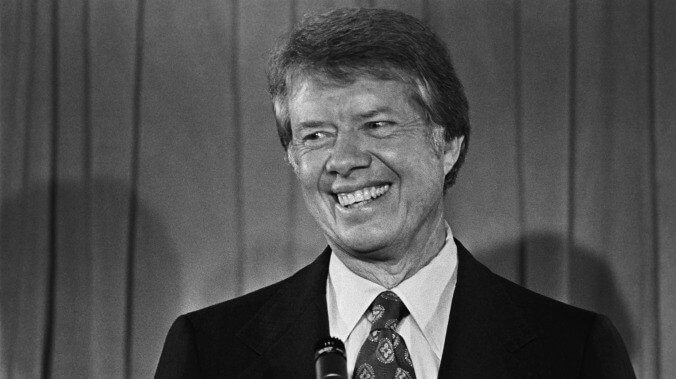Young Jimmy Carter once averted a nuclear disaster

We explore some of Wikipedia’s oddities in our 6,033,951-week series, Wiki Wormhole.
This week’s entry: Chalk River Laboratories
What it’s about: A thrilling nuclear crisis, narrowly averted by a future president, which is shockingly a real life event and not an early ’90s Harrison Ford movie. And its setting, an Ottawa research facility that ran multiple nuclear reactors from 1944 until 2018.
Strangest fact: The Queen Of England is the ultimate authority on Canadian nuclear power. In 2007, Chalk River’s National Research Universal reactor (NRU) was shut down for routine maintenance, and the Canadian Nuclear Safety Commission (CNSC) decided to extend the shutdown to add more backup power systems. The only problem was, as mentioned last week, Chalk River—specifically the NRU—provides nearly all of the medical isotopes for North America, and shutting down the reactor caused a worldwide shortage.
Canada’s House Of Commons overruled the CNSC and ordered the reactor to be restarted for 120 days, and then-Prime Minister Stephen Harper criticized the shutdown. Safety Commission CEO Linda Keen was fired, and the reactor was restarted after less than a month offline, safety concerns be damned. But the order to reopen wasn’t official until it received Royal Assent. While Canada has officially been independent since 1982 (and independent within the British Commonwealth since 1867), the country was too polite to stop asking for royal approval for its laws. Her Majesty doesn’t appear in person, but the Governor General acts in her stead, in a ceremony that involves people with titles like Mace Bearer (this is not figurative; the bearer holds an actual mace), and Usher Of The Black Rod, which would also make a pretty bitchin’ black metal album title.
Thing we were happiest to learn: Future president Jimmy Carter saved the day. In 1952, one of the other reactors, the NRX, underwent what’s euphemistically called a “power excursion,” and is in fact an uncontrolled chain reaction. Part of the reactor’s coolant was lost, the core was damaged, and as a result the fuel rods were overheated. The reactor melted down, a series of explosions further damaged the reactor, and 4,500 tons of radioactive water flooded the basement. The U.S. Navy sent in a 26-man rescue team, based in Schenectady, New York, led by a young Jimmy Carter. The cleanup was successful enough that within two years, the reactor was back online.
Thing we were unhappiest to learn: Carter’s victory over the atom was short-lived. Only six years after the NRX melted down, the NRU suffered a fuel rupture, which started a fire, overheating some fuel rods. The mechanical arm charged with pulling the uranium rods out of the reactor broke when the uranium caught fire. The rod broke and fell down into the reactor, irradiating the whole building. When the building was ventilated, the surrounding area was also contaminated. Laboratory staff put out the fire with buckets of wet sand, but the aftermath required another joint civilian-military cleanup effort. Thankfully, no one suffered long-term health effects. And surprisingly, after two accidents in six years, the plant was put back online and ran without incident until the 2007 shutdown.
Also noteworthy: The Chalk River complex has more than just those two reactors. The first reactor at the site was the Zero Energy Experimental Pile Reactor (ZEEP), which opened in 1943 and shuttered in 1973. NRX was built four years later, and NRU ten years after that. Also in 1957 came the Pool Test Reactor (PTR). The Zero Energy Deuterium Reactor (ZED) arrived in 1960, as did the Nuclear Power Demonstration reactor (NPD). 1970 brought SLOWPOKE, the Safe Low-Power Kritical [sic] Experiment Reactor, which somehow moved to the University Of Toronto the following year. But before it did, Chalk River had seven different nuclear reactors going.
Best link to elsewhere on Wikipedia: Hard to beat the Manhattan Project, the biggest top-secret science experiment in history. While the Los Alamos lab run by Robert Oppenheimer is the location one thinks of for the project, the joint U.S.-U.K.-Canadian effort spread across more than 30 sites across all three countries, and at its peak employed 130,000 people, all of whom managed to keep a lid on the project long enough for the atomic bomb to be developed and dropped on Japan to end WWII.
Further Down the Wormhole: One thing we’ve never mentioned about Wikipedia is that pages that deal with specific locations often have geographic coordinates. In this case, the Chalk River lab is located at 46.05ºN by 77.36ºW. The idea of a coordinate system is credited to Eratosthenes of Cyrene in the 3rd century B.C. It was tinkered with and improved through the centuries until the U.S. hosted a 25-country summit to standardize longitude and latitude in 1884. Twenty-two of the countries agreed on the system that’s become the world standard, with 0º set at the Royal Observatory in Greenwich, England.
The Observatory itself is now a museum, and while it’s one of England’s most significant historical sites, it can’t be said to be the rockingest. That distinction goes to Handel & Hendrix, a museum that jointly celebrates two musical giants who were next-door neighbors, give or take 210 years. We’ll sing “Hallelujah” and then kiss the sky next week.